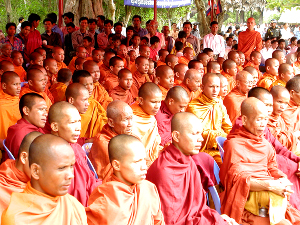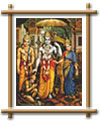Core beliefs of Buddhism:
Buddhism, like most of the great religions of the world, is divided into a number of different traditions. However, most traditions share a common set of fundamental beliefs.One fundamental belief of Buddhism is often referred to as reincarnation -- the concept that people are reborn after dying. In fact, most individuals go through many cycles of birth, living, death and rebirth. A practicing Buddhist differentiates between the concepts of rebirth and reincarnation. In reincarnation, the individual may recur repeatedly. In rebirth, a person does not necessarily return to Earth as the same entity ever again. He compares it to a leaf growing on a tree. When the withering leaf falls off, a new leaf will eventually replace it. It is similar to the old leaf, but it is not identical to the original leaf.
After many such cycles, if a person releases their attachment to desire and the self, they can attain Nirvana. This is a state of liberation and freedom from suffering.
The Three Trainings or Practices:
These three consist of:- Sila: Virtue, good conduct, morality. This is based on two fundamental principles:

The principle of equality: that all living entities are equal.

The principle of reciprocity: This is the "Golden Rule" in
Christianity -- to do onto others as you would wish them to do
onto you. It is found in all major religions.
- Samadhi: Concentration, meditation, mental development. Developing one's mind is the path to wisdom which in turn leads to personal freedom. Mental development also strengthens and controls our mind; this helps us maintain good conduct.
- Prajna: Discernment, insight, wisdom, enlightenment. This is the real heart of Buddhism. Wisdom will emerge if your mind is pure and calm.
The Four Noble Truths:
The Buddha's Four Noble Truths explore human suffering. They may be described (somewhat simplistically) as:- Dukkha: Suffering exists: (Suffering is real and almost universal. Suffering has many causes: loss, sickness, pain, failure, the impermanence of pleasure.)
- Samudaya: There is a cause for suffering. (It is the desire to have and control things. It can take many forms: craving of sensual pleasures; the desire for fame; the desire to avoid unpleasant sensations, like fear, anger or jealousy.)
- Nirodha: There is an end to suffering. (Suffering ceases with the final liberation of Nirvana (a.k.a. Nibbana). The mind experiences complete freedom, liberation and non-attachment. It lets go of any desire or craving.)
- Magga: In order to end suffering, you must follow the Eightfold Path.
The Five Precepts:
These are rules to live by. They are somewhat analogous to the second half of the Ten Commandments in Judaism and Christianity -- that part of the Decalogue which describes behaviors to avoid. However, they are recommendations, not commandments. Believers are expected to use their own intelligence in deciding exactly how to apply these rules.- Do not kill. This is sometimes translated as "not harming" or an absence of violence.
- Do not steal. This is generally interpreted as including the avoidance of fraud and economic exploitation.
- Do not lie. This is sometimes interpreted as including name calling, gossip, etc.
- Do not misuse sex. For monks and nuns, this means any departure from complete celibacy. For the laity, adultery is forbidden, along with any sexual harassment or exploitation, including that within marriage. The Buddha did not discuss consensual premarital sex within a committed relationship; Thus, Buddhist traditions differ on this. Most Buddhists, probably influenced by their local cultures, condemn same-sex sexual activity regardless of the nature of the relationship between the people involved.
- Do not consume alcohol or other drugs. The main concern here is that intoxicants cloud the mind. Some have included as a drug other methods of divorcing ourselves from reality -- e.g. movies, television, the Internet. 1
6. Taking untimely meals.
7. Dancing, singing, music, watching grotesque mime.
8. Use of garlands, perfumes and personal adornment.
9. Use of high seats.
10. Accepting gold or silver.
There is also a series of eight precepts which are composed of the first seven listed above, followed by the eighth and ninth combined as one. "Ordained Theravada monks promise to follow 227 precepts!" 3
The Eightfold Path:
The Buddha's Eightfold Path consists of:Panna: Discernment, wisdom:
| |||||||
Sila: Virtue, morality:
| |||||||
Samadhi: Concentration, meditation:
|






